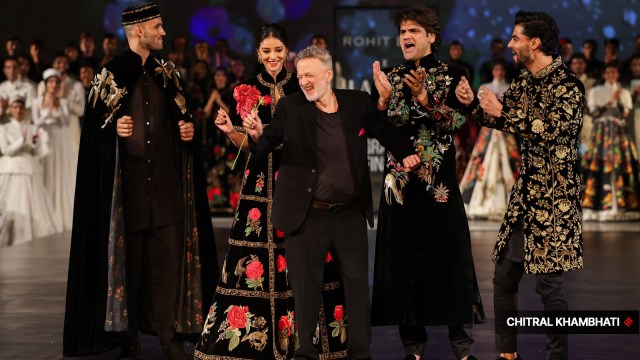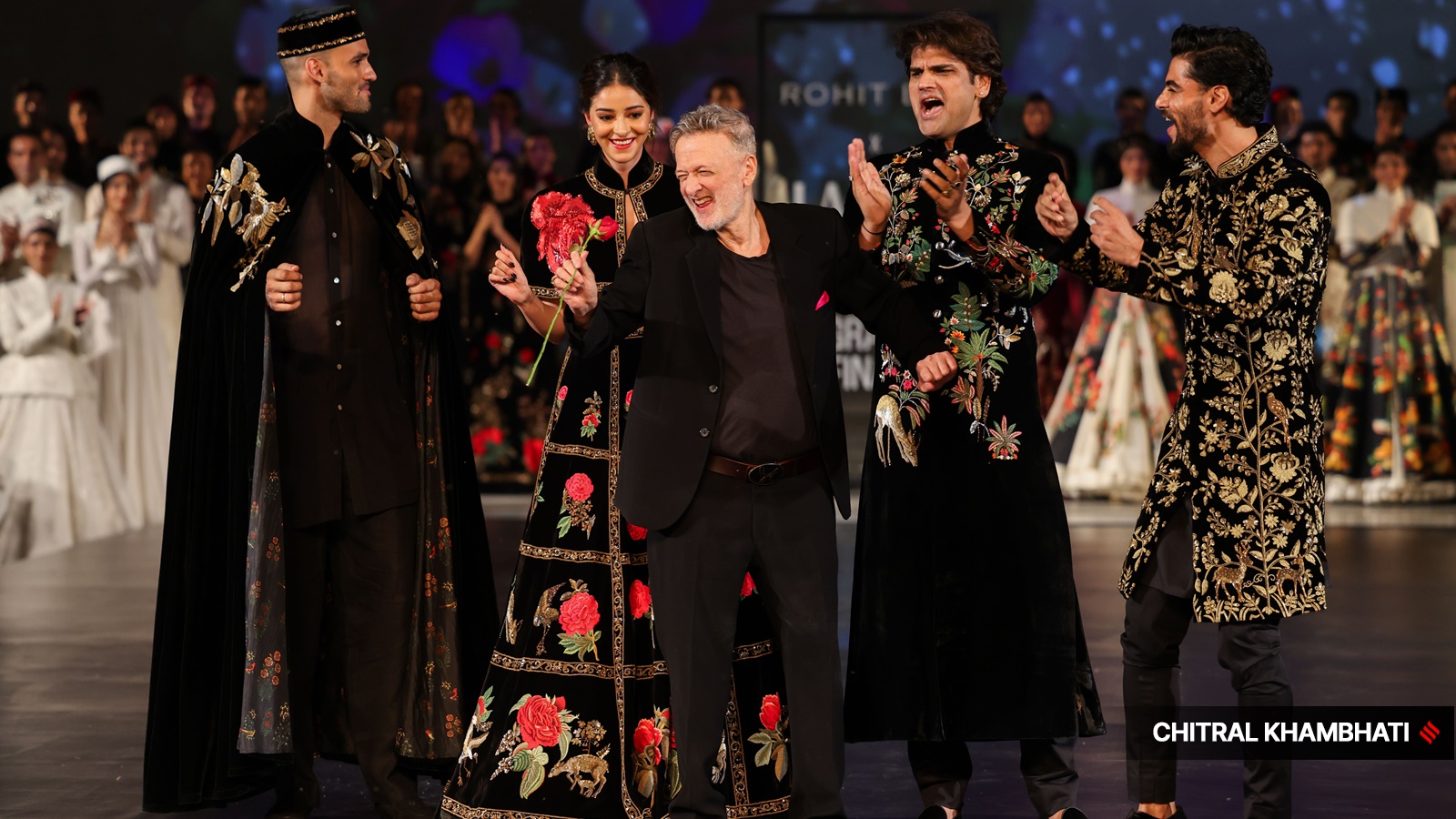
We will always need a Rohit Bal around to show what classic elegance is — and why it crosses the generational divide. In his comeback show on Sunday night, after battling illness and health complications, fashion’s enfant terrible showed why he is still the OG. Just when everybody had written him off, the gaunt man in black with white hair, wizened by experience, held a red rose in his hand and jiggled side to side, held up by Gen Z models and their icon Ananya Pandey.
As Bal, lavished not just with attention but admiration, teared up, it was not, as some on social media speculated, a swan song. Rather, his show was a masterclass in how legacy fashion brands can remain true to their grain and yet speak a contemporary language. And if India is ever to be a global fashion capital, there were many takeaways from Bal’s show, which cleverly used digital tools like projection mapping to show giant red roses blooming on the façade of The Imperial as models sashayed down the garden area.
The flowing lines, the capes and caps, the subtle layering and the gossamer throws laid the template of what fashion could be in a world of fluid identities. Some of the men’s and women’s collections were easily interchangeable, which is a territory that most designers do not steer into. Bal also won by the sheer flourish and balance of his floral — mostly the red rose — and nature motifs, usually appearing kitschy in others. His colour palette moved from the luminescence of ivory to the darker and conservative grey, black and maroon. The cuts were all taut, spartan and clean, making the collection as much European, as it was Central Asian and Indian. And at a time when the ramp is all about screaming drama, be it in colour pops, embellishment or bling, Gudda — as Bal is affectionately known — showed why in-your-face excess doesn’t last beyond an Instagram reel. The embroidered patches — long-tailed parrots, elephants, cockatoos, horses, flowers and leaves — peeped through jacket corners, pleats, lapels, borders, cuffs, and in men, on their churidars. The identity markers were never force-fed.
Many designers in India just pay lip service to their pret lines. But Bal, who was among the first to attempt ready-to-wear with khadi shirts, collaborated with Indian brands like HiDesign, Titan and Biba for pret collections, his own Balance coming many years later. He didn’t go to a French fashion house. His weaves, quilted fabric and craftsmanship reminded us how tradition should not only be packaged for modernity but “lastability” as well. And pret could afford luxuriant touches if done smartly and marketed well. Long before it became de rigeur, Bal understood how to create sub-categories within pret, like high street and mass retail.
The show silently broke the ageist bias as it momentarily brought back the abandon of the newly-liberalised ’90s. So, although Pandey was a showstopper, supermodel Sheetal Mallar showed youngsters what it is to own the ramp in the opening act. Bal’s peers like J J Valaya and those he inspired, like Rajesh Pratap Singh, Gaurav Gupta, Ashish N Soni and Samant Chauhan, cheered him from the flanks, dancing to ’90s hits that played in the background, showing how brands have to be egoless to coalesce.
But what many didn’t know was that Bal had also invited several faceless customers, regardless of when they last bought his work, as a token of his gratitude. That’s the kind of PR and brand loyalty he has worked on over the years. It beats any data-driven sales pitch.
Although the show was the closing act of the Reliance group-sponsored Lakme Fashion Week, Bal is one of the few designers who hasn’t sold out to a corporate major yet. The pandemic changed Bal. He became a recluse, refused interviews and hated “phygital” shows, primarily because they took “human creativity out of his hands.” Will he be able to hold out with even his peers and juniors selling out?
But that’s the thing about Bal: He’s fiercely protective about his individuality and has so far managed to avoid the cloning that commercialisation forces upon the design fraternity. Bal is too used to bravos and he certainly didn’t need one that night. But as Madonna’s ‘Vogue’ played in the background, he knew how to “strike a pose.”
rinku.ghosh@expressindia.com
© The Indian Express Pvt Ltd
First uploaded on: 15-10-2024 at 17:56 IST



